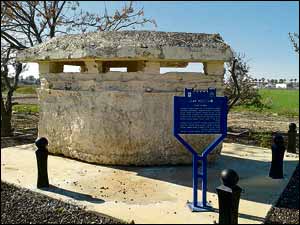 | |
| If only walls could talk — in Afula they certainly do | |
One of those in the southern approaches to the city was of concrete and of British army ‘pillbox’ style — round in shape with wide, narrow slits for the soldiers to clearly but safely see through, and fire from. The major threat to Afula at that time was from the Arab populated city of Nazareth, sitting on a mountain range behind the developing Jewish one nestled in the eastern plains of the Jezreel Valley below. Another serious threat was from the Arab town of Jenin and environs. Today, Jenin is an autonomous Palestinian city in the northern part of the West Bank and a very short distance indeed across the valley floor from Afula. Apart from the hastily constructed concrete ‘pillbox’ defences, others were built from sandbags with all of those positions manned by older members of the Hagana who had not been sent to the front, which in fact would not have been very far from them anyway. In 2014, the remains of the pillbox at the southern entrance to the town of Afula were moved from their original site to another part of the outskirts of the town, repositioned on a concrete base and surrounded by metal bollards — the new site still in the southern approaches to the town. After the 1948 War of Independence and over the following decades, the pillbox slowly sank in its original place and much of it became covered in soil. The Afula Municipality, together with the Society of Preservation of Israel Heritage Sites, the Israel Ministry of Tourism and the Israel Ministry of Culture and Sport — already undertaking a number of heritage projects in the town — decided to dig up the past, literally, and save the half-buried Independence period pillbox. A bright blue metal sign with white lettering gives basic information about the 1948 defence position. It now proudly stands on the corner of a grassy verge alongside a busy road, right opposite a school in a new area of high-rise apartments in the rapidly expanding present day city of around 40,000. Other recently renovated — or still under renovation — major historical sites in Afula include the Turkish built railway station and water tower in the centre of town. An attractive park is being developed around the buildings and original station platform — the latter part already completed and slowly becoming an attraction for locals and visitors from elsewhere. Along the station, comfortable seating is now in place under canvas coverings, every few metres an informative board giving details of the various stations that would have been in use during the Turkish and British periods along the Beit Shean to Haifa line. The first trains rumbled through Afula in the early 1900s but the line was closed by the British in 1946 until rebirth in October, 2016, the present day railway track having been moved to the outskirts of the city and a modern station built there. On the side of the renovated Turkish-built water tower hangs a poster showing a black and white photograph of a typical scene in the early days. A young man, clad in khaki shorts and shirt, wide brimmed hat jauntily sitting towards the back of his head, straddles a somewhat rickety motorbike. Behind him a trio of camels wanders nonchalantly by, kicking up dust, whilst in the back ground a black, soft topped car is parked alongside the water tower and other station buildings. Yet another poster is affixed to a hewn stone old station building. This one contains a number of photographs and Hebrew only text, and almost missed because of the angle of the wall. The poster, with the orange and green emblem of the Afula Municipality printed on the bottom corner, stopped me in my tracks as the blood chilling concentration camp entrance sign Arbeit Mach Frei became visible in black and white, a sepia photograph of the Afula railway station and tracks in the 1940s skilfully worked in alongside. The text tells of a train from Nazi-controlled Europe arriving at Afula station on November 14, 1942. Aboard were “69 Jews from Eretz Israel who had become trapped in Europe at the outbreak of the war. “The 69 Jews were exchanged for German nationals (Templars) who were viewed by the British in Palestine as a Fifth Column and detained. “The new arrivals were warmly welcomed by Afula Jews who served them a hot meal”,"states the sign before continuing: “The returnees were the first to bring news of the destruction of European Jewry (Final Solution) and for the first time in Israel news became known of Auschwitz, Treblinka, Sobibor. As a result of their testimonies the Jewish Agency announced the news, quoting “reliable sources”, that the Nazis had begun the annihilation of Jews, leading to demonstrations throughout the country, Hebrew language newspapers appearing with black borders around the pages. If only walls could talk, they say. In Afula, they certainly are, silently, emotionally and powerfully sharing the past in present times. * In three different operations brokered between the British and Germans, some 282 Jews were released by the Nazis in exchange for Nazis supporting German Templars held by the British in Mandate Palestine. Of those released, 222 were mostly Dutch Jews from the Bergen-Belsen concentration camp, 10 from a German town, Laufen, and another 50 from the French town of Vitel.
If you have a story or an issue you want us to cover, let us know - in complete confidence - by contacting newsdesk@jewishtelegraph.com, 0161-741 2631 or via Facebook / Twitter
|
 The renovated 1948 Hagana-built pillbox in Afula, now moved from its originally site
The renovated 1948 Hagana-built pillbox in Afula, now moved from its originally site